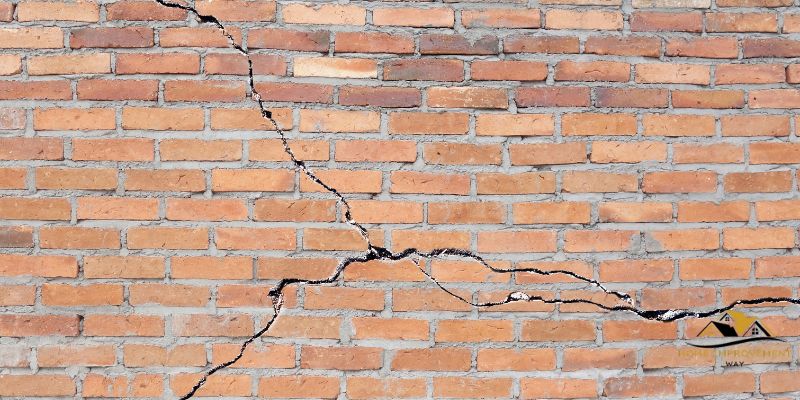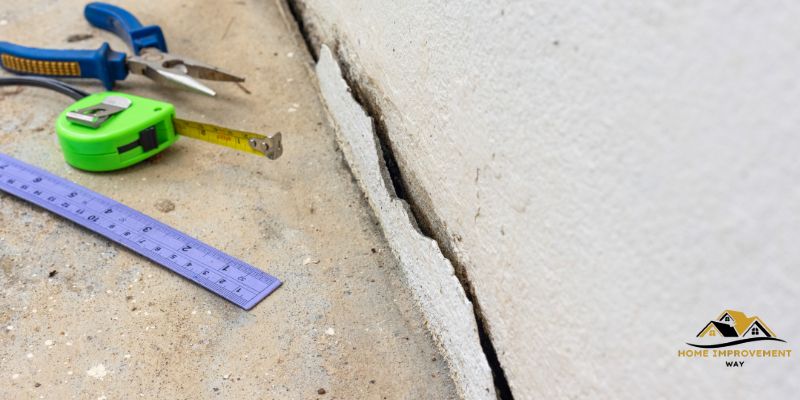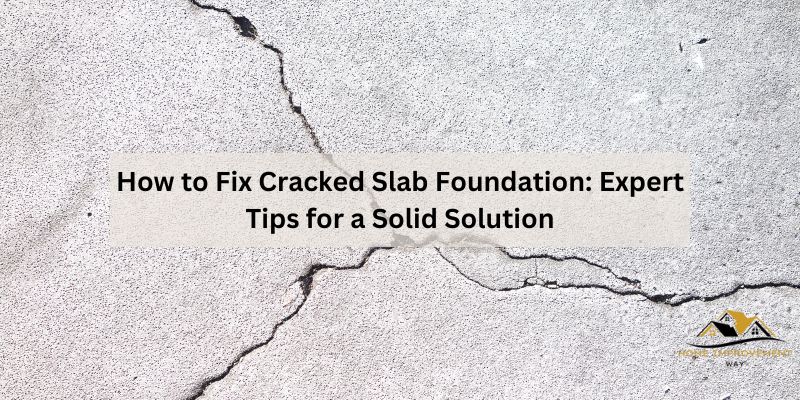To fix a cracked slab foundation, hire a professional foundation repair contractor for an assessment and recommended solution. A cracked slab foundation can be a cause for concern as it can lead to structural issues in a building.
If left unaddressed, it may worsen over time and affect the stability of the entire structure. Therefore, it is crucial to take corrective action as soon as possible. We will discuss the steps to fix a cracked slab foundation, from identifying the problem to implementing the appropriate solution.
By following these guidelines, you can ensure the safety and longevity of your building. So, let’s dive in and learn about the effective ways to fix a cracked slab foundation.
Understanding Cracked Slab Foundations
Understanding cracked slab foundations is crucial for homeowners facing structural issues. Discovering how to fix these cracks is essential to prevent further damage and maintain the integrity of the foundation.
Causes Of Cracked Slab Foundations
Cracked slab foundations can be a worrisome issue for many homeowners. Understanding the causes of these cracks is crucial in order to effectively address the problem. Oftentimes, these cracks are a result of:
- Poor construction techniques: In some cases, cracked slab foundations may be a consequence of improper construction methods. This can include insufficient reinforcement or the use of low-quality materials.
- Soil movement: Changes in soil moisture content, soil settlement, or expansion and contraction of clay soils can cause the foundation to crack. This is particularly common in areas with clay-rich soils.
- Hydrostatic pressure: Excessive water pressure around the foundation can lead to cracks. This pressure can build up due to poor drainage, heavy rainfall, or improper grading.
- Tree roots: The roots of nearby trees can exert pressure on the foundation, causing it to crack. This is especially true if the trees are planted too close to the house.
- Plumbing issues: Leaking water or damaged plumbing lines beneath the slab can contribute to foundation cracks. The constant presence of moisture can weaken the soil and compromise the stability of the foundation.
Signs Of A Cracked Slab Foundation
Detecting cracks in a slab foundation at an early stage is crucial to prevent further damage. Some visible signs that may indicate a cracked slab foundation include:
- Visible cracks in the floor: Cracks on the floor can be a clear indication of foundation issues. Look out for cracks that are wider than a quarter of an inch or that have jagged edges.
- Uneven or sloping floors: If you notice that your floors are no longer level, it could be a sign of a compromised foundation. Pay attention to any areas where the floor slopes or feels uneven.
- Doors and windows that stick: Cracked slab foundations can cause the doors and windows in your home to become misaligned. This can make them difficult to open or close, or they may stick when attempting to do so.
- Gaps between walls and ceilings: Cracks or separation between the walls and ceilings can also indicate foundation problems. Keep an eye out for any noticeable gaps or cracks in these areas.
- Cracks in exterior walls: In some cases, cracks may appear on the exterior walls of your home, particularly around doors and windows. These cracks should not be ignored, as they can also be signs of a compromised foundation.

Impact Of Ignoring Cracked Slab Foundations
While it may be tempting to overlook or postpone repairing a cracked slab foundation, doing so can lead to serious consequences. Ignoring these cracks can result in:
- Structural damage: Cracked foundations can lead to more extensive structural damage to your home over time. The cracks can weaken the overall integrity of the foundation, causing it to become increasingly unstable.
- Water damage: Cracks in the foundation can allow water to seep into your home, leading to water damage, mold growth, and other related issues. This can further impact the indoor air quality and the overall health of your household.
- Decreased property value: A cracked slab foundation can significantly reduce the value of your property. Potential buyers may be hesitant to invest in a home with a compromised foundation, leading to difficulties in selling your home in the future.
- Increased repair costs: Delaying foundation repairs can result in higher costs down the line. The longer the problem persists, the more extensive the repairs may become, potentially requiring major interventions such as underpinning or foundation replacement.
If you suspect that your home has a cracked slab foundation, it is important to consult with a professional foundation repair specialist. They can assess the severity of the issue and recommend the most suitable course of action to address and fix the problem.
Identifying The Severity Of Cracked Slab Foundations
Cracked slab foundations can vary in severity, making it essential to identify the extent of the problem before determining how to fix it. By assessing the cracks’ width, length, and depth, professionals can determine the appropriate repair methods to ensure a solid foundation.
Visual Inspections
When it comes to fixing a cracked slab foundation, the first step is to accurately identify the severity of the damage. Visual inspections can provide valuable insights into the condition of the foundation and help determine the necessary course of action.
- Begin the visual inspection by examining the exterior of your home. Look for any visible signs of foundation cracks, such as vertical or diagonal lines in the concrete.
- Pay close attention to doors and windows. If you notice any sticking, uneven frames, or difficulty in opening and closing, it could be an indication of foundation movement.
- Inspect the interior of your home, focusing on areas where cracks might be more likely to occur, such as near corners, windows, or doors.
- Look for any noticeable cracks in the walls, ceilings, or floors. Be sure to measure the width and length of these cracks for future reference.
Structural Assessments
If visual inspections raise concerns about the severity of the issues found during the initial assessment, it may be necessary to conduct a more thorough structural assessment. This step requires the expertise of a professional to accurately evaluate the condition of the foundation.
- Consult with a structural engineer or foundation specialist who can assess the extent of the damage and provide a detailed analysis.
- During the assessment, the professional will inspect the foundation by taking measurements, examining load-bearing structures, and conducting tests to determine the structural integrity.
- Based on the findings of the structural assessment, the professional will be able to provide recommendations for the necessary repairs or interventions.
Invasive Testing
Invasive testing may be required in certain cases where the severity of the cracked slab foundation cannot be accurately determined through visual inspections and structural assessments alone. This step involves more intrusive techniques to gather detailed information about the condition of the foundation.
Methods of invasive testing may include:
| Testing Method | Description |
|---|---|
| Borehole Testing | Drilling small holes into the foundation to collect soil samples and assess soil composition and moisture levels. |
| GPR (Ground Penetrating Radar) | Using radar technology to create a subsurface profile of the foundation, identifying potential voids, delaminations, or other anomalies. |
Through invasive testing, professionals can gather more accurate data about the condition of the foundation and determine the most appropriate repair strategies.

Effective Solutions For Fixing Cracked Slab Foundations
Cracks in a slab foundation can be a cause for concern for homeowners, as they can lead to more serious structural issues if left untreated. Fortunately, there are effective solutions available to fix cracked slab foundations. In this article, we will explore three popular methods: epoxy injection, slab jacking, and underpinning techniques. By understanding these solutions, you can make an informed decision about the best approach to address your cracked slab foundation.
Epoxy Injection
Epoxy injection is a widely used technique for repairing cracks in slab foundations. It involves injecting epoxy resin into the cracks to bind them together and restore the strength of the foundation. This method is suitable for both small and large cracks, and it provides a durable and long-lasting solution.
Here’s how the epoxy injection process works:
- The cracks are cleaned and prepared by removing any loose debris.
- An epoxy resin is mixed according to the manufacturer’s instructions.
- The epoxy resin is injected into the cracks using specialized equipment.
- The resin fills the cracks, bonding the concrete back together.
- Once the epoxy has cured, the cracks are sealed, leaving a smooth and structurally sound foundation.
Slab Jacking
Slab jacking, also known as mud jacking or concrete leveling, is another effective method for fixing cracked slab foundations. This technique is particularly useful when the cracks have occurred due to uneven settling of the soil beneath the foundation.
Here’s how slab jacking works:
- Small holes are drilled into the affected slab.
- A specialized grout mixture, often made of sand, cement, and additives, is pumped into the holes.
- The grout mixture fills the voids under the slab, raising it to the desired level.
- As the slab is raised, the cracks are closed, restoring the foundation’s integrity.
- The holes are patched, leaving minimal evidence of the repair.
Underpinning Techniques
Underpinning is a more complex and invasive technique used to fix cracked slab foundations. It involves strengthening and stabilizing the foundation by extending it deeper into the ground.
Here are some common underpinning techniques:
| Technique | Description |
|---|---|
| Bell Bottom Piers | Large circular holes are dug beneath the foundation, and concrete piers are inserted to support and stabilize the structure. |
| Steel Piers | Steel piers are driven into the ground until they reach stable soil or bedrock, providing support to the foundation. |
| Screw Piles | Helical steel piles are screwed into the ground, providing anchorage and support to the foundation. |
Underpinning is typically recommended for severe cases of foundation damage or when the soil conditions are highly unstable.
Conclusion
To sum up, addressing a cracked slab foundation is crucial to maintain the structural integrity of your home. By identifying the underlying cause, whether it’s moisture or soil settlement, and taking immediate action, you can prevent further damage and costly repairs down the line.
Whether you choose to DIY or hire a professional, remember that early intervention is key. Don’t postpone fixing the issue and ensure a strong and stable foundation for your home.


